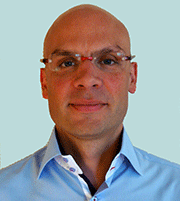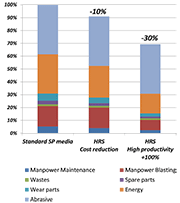E-Archive
Interview
in Vol. 14 - May Issue - Year 2013
Making Grey Matter!

Tony Prezeau, Corporate Research and Innovation Director of Winoa

Axel De Lavernhe, Business Development & Specialties Products Manager of Winoa

A spring shotpeening with the HRS media

Micro deburring application

Cost simulations
MFN was able to get an interview with Tony Prezeau, Corporate Research and Innovation Director and Axel De Lavernhe, Business Development & Specialties Products Manager of Winoa.
(?) MFN: What are your latest innovations in the field of shot peening?
(!) T. P.: We have recently developed and patented two highly innovative atomized steel shots that bring new possibilities to shot peeners, in terms of blasting cost reduction and of performance increases of blasted parts. These new products are Hard Resilient Shots (HRS) and Ultra-Fine Shots (UFS).
(?) MFN: Can you tell us more about HRS?
(!) T. P.: HRS is a new shot peening media, made by a proprietary production process, showing an exclusive combination of high hardness and high lifetime. Indeed, HRS is characterized by a very high hardness level, in the range 60-64HRc (700-780 HV), combined with a high toughness/impact resistance. This combination allows being cost-competitive versus standard shot peening solutions. The presently available sizes fit most industrial applications.
In order to bring to customers the highest quality, HRS material undergoes very strict quality controls; very similar to aerospace material specifications.
(?) MFN: What kind of parts can be treated with HRS?
(!) A. D. L.: Our core targeted market is the suspension industry (automotive or non-automotive sectors): leaf springs, coil springs, torsion bars, stabilizers... More generally, HRS can be used in any application that needs high Almen intensity values.
(?) MFN: What are the benefits of HRS for the customers?
(!) A. D. L.: The high hardness of HRS results in a high peening efficiency, allowing the user:
To reduce its peening costs: by reducing the blasting velocity compared to standard products (cut wire pellets or standard cast steel shots) while keeping the same (and even higher) results on blasted parts. It results in a global blasting cost reduction around -10% (through lower energy consumption and lower maintenance costs).
To increase peening productivity: by combining the velocity reduction mentioned above with an increase of abrasive flow rate. It results in an increase of the blasting line capacity up to +100% for wheelblasting and +40% for airblasting installations, for a global blasting cost reduction up to -30%.
To treat higher performance (harder) materials that are not treatable with currently available products because of their hardness limitation. The increase of the hardness of mechanical parts is a global trend, driven by environmental constraints (weight reduction, downsizing...); higher hardness abrasives are more and more required.
(?) MFN: What about UFS?
(!) T. P.: UFS are very fine high-carbon steel shots (size range: 50-150 µm) dedicated to both precise shot peening and double peening operations. Due to their specific production process, they combine:
a high hardness (770-900Hv) and density, ensuring good energy transfer to the blasted parts and a high rebound capacity.
a highly spherical shape (due to an exclusive production process) in order to respect the surface integrity of blasted parts.
a long lifetime/low consumption
(?) MFN: What kind of parts can be treated with UFS?
(!) T. P.: With Ultra Fine Shots, we can treat small/thin/complex parts such as CVT belt components and small gears and ensure a good surface quality for parts such as valve springs (second peening).
(?) MFN: What are the benefits of UFS for the customers?
(!) A. D. L.: Thanks to the combination of unique properties, benefits brought by UFS are the following:
a high peening efficiency leading to a high level of residual stresses in the near-surface region.
a low roughness generation.
a high cost effectiveness compared to non-metallic media.
Studies carried-out by our university partners show that UFS can significantly increase the fatigue limit of notched parts. Compared to unpeened specimens, the existing media led to a fatigue limit increase of 12%, while UFS lead to a fatigue limit increase of 30%.
In addition to being a shot peening media, UFS can also be used for the surface finishing of metallic parts. Indeed, the fine size, hardness, density and high level of roundness of this product allows decreasing the roughness of the blasted surface to very low levels, below 0.2 µm, without suppressing edges (micro-deburring).
We have also patented special blasting equipment (COP) to improve control of the fine blasting process to enable even more innovative applications such as surface texturing.
(?) MFN: Are you working on other solutions in addition to UFS and HRS?
(!) T. P.: First of all, we are not only shot peening media producers, but we also have a knowledge of other blasting applications such as surface cleaning and surface preparation. Did you know that nowadays, the largest cause of spring breaking is not fatigue, but coating failure leading to destructive corrosion? We are then in a unique position to provide support both to optimize peening efficiency and a subsequent good coating adhesion, at an optimized global cost.
In addition, our R&D activities are not only focused on the development of new Premium peening/blasting products but we are also working on a breakthrough blasting process called NanoPeening®.
The objective of this treatment is not to create residual stresses but to create a layer of nanostructured grains at the surface of metals. We are then not only improving fatigue properties but also wear resistance, chemical properties such as corrosion resistance, diffusion coefficients...
It opens a wide field of applications, some of which have already been validated at the industrial scale. For instance, we observed a service life increase of forging dies by around 30% at several customers, when applying NanoPeening® before their usual nitriding treatment.
Our group mission is to team up with our customers to transform their products' surfaces with easy to use, economical and ecological solutions and these new developments really fit with this ambition!
MFN would like to thank Tony Prezeau and Axel De Lavernhe for the interview!
For Information:
Winoa
528 avenue de Savoie
38570
Le Cheylas, France
Tel. +33.4.76 92 92 20
E-mail: tony.prezeau@
winoagroup.com
axel.delavernhe@
winoagroup.com
www.winoagroup.com
www.wabrasives.com



























